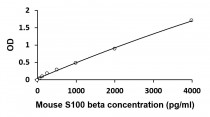ARG82656
Mouse S100 beta ELISA Kit
Mouse S100 beta ELISA Kit for ELISA and Mouse
Overview
| Product Description | ARG82656 Mouse S100 beta ELISA Kit is an Enzyme Immunoassay kit for the quantification of Mouse S100 beta in serum, plasma and cell culture supernatants. |
|---|---|
| Tested Reactivity | Ms |
| Tested Application | ELISA |
| Specificity | The following recombinant Mouse proteins were tested and exhibited no cross-reactivity or interference: BMP1, BMP2, BMP4, BMP7, CRP, CCL2, CCL4, CCL5, HGF, HSP27, IGF1, IL1 beta, IL2, IL4, IL5, IL6, IL8, IL12, IL13, IL15, IL17C, IL21, IFN gamma, PDGF, PLA2G7, S100A1, S100A2, Serpin E1, TGF beta 1, TGF beta 2, TGF beta 3, TLR1, TLR2, TLR3, TLR9, TNF alpha, TNF RI, TNF RII, VEGF, VEGF R1. |
| Target Name | S100 beta |
| Conjugation | HRP |
| Conjugation Note | Read at 450 nm. |
| Sensitivity | 31 pg/ml |
| Sample Type | Serum, plasma and cell culture supernatants. |
| Standard Range | 62 - 4000 pg/ml |
| Sample Volume | 100 µl |
| Precision | Intra-Assay CV: 5% Inter-Assay CV: 8% |
| Alternate Names | S-100 protein beta chain; NEF; S100; Protein S100-B; S100 calcium-binding protein B; S100beta; S-100 protein subunit beta; S100-B |
Application Instructions
| Assay Time | ~ 3 hours |
|---|
Properties
| Form | 96 well |
|---|---|
| Storage Instruction | Store the kit at 2-8°C. Keep microplate wells sealed in a dry bag with desiccants. Do not expose test reagents to heat, sun or strong light during storage and usage. Please refer to the product user manual for detail temperatures of the components. |
| Note | For laboratory research only, not for drug, diagnostic or other use. |
Bioinformation
| Database Links | |
|---|---|
| Gene Symbol | S100B |
| Gene Full Name | S100 calcium binding protein B |
| Background | The protein encoded by this gene is a member of the S100 family of proteins containing 2 EF-hand calcium-binding motifs. S100 proteins are localized in the cytoplasm and/or nucleus of a wide range of cells, and involved in the regulation of a number of cellular processes such as cell cycle progression and differentiation. S100 genes include at least 13 members which are located as a cluster on chromosome 1q21; however, this gene is located at 21q22.3. This protein may function in Neurite extension, proliferation of melanoma cells, stimulation of Ca2+ fluxes, inhibition of PKC-mediated phosphorylation, astrocytosis and axonal proliferation, and inhibition of microtubule assembly. Chromosomal rearrangements and altered expression of this gene have been implicated in several neurological, neoplastic, and other types of diseases, including Alzheimer's disease, Down's syndrome, epilepsy, amyotrophic lateral sclerosis, melanoma, and type I diabetes. [provided by RefSeq, Jul 2008] |
| Function | Weakly binds calcium but binds zinc very tightly-distinct binding sites with different affinities exist for both ions on each monomer. Physiological concentrations of potassium ion antagonize the binding of both divalent cations, especially affecting high-affinity calcium-binding sites. Binds to and initiates the activation of STK38 by releasing autoinhibitory intramolecular interactions within the kinase. Interaction with AGER after myocardial infarction may play a role in myocyte apoptosis by activating ERK1/2 and p53/TP53 signaling. Could assist ATAD3A cytoplasmic processing, preventing aggregation and favoring mitochondrial localization. May mediate calcium-dependent regulation on many physiological processes by interacting with other proteins, such as TPR-containing proteins, and modulating their activity. [UniProt] |
| Cellular Localization | Cytoplasm. Nucleus. [UniProt] |
| Highlight | Related products: S100 beta antibodies; S100 beta ELISA Kits; New ELISA data calculation tool: Simplify the ELISA analysis by GainData |
Images (1) Click the Picture to Zoom In
| Title | Download Link |
|---|---|
| ARG82656 Mouse S100 beta ELISA kit User manual |
 Download Download
|






